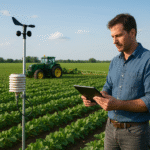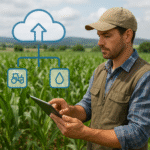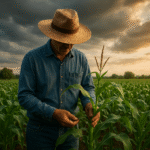In the realm of impressive agriculture, data-driven farming represents a leap forward in optimizing resources and maximizing returns. By integrating cutting-edge sensors, robust analytics, and real-time decision-making tools, growers can achieve unprecedented levels of efficiency and sustainability. This article explores how modern technologies bridge the gap between field data and profitability, providing actionable strategies for the next generation of agribusinesses.
The Rise of Sensor Technologies on the Farm
Types of Sensors and Their Applications
Modern farms deploy a diverse array of sensors to monitor everything from soil moisture to crop health. Common implementations include:
- Soil Moisture Probes: Measure volumetric water content to guide irrigation schedules.
- NDVI Cameras: Capture spectral data to assess plant vigor and detect stress before visible symptoms appear.
- Weather Stations: Record temperature, humidity, wind speed, and rainfall, feeding local models for pest and disease forecasting.
- pH and EC Sensors: Monitor soil acidity and electrical conductivity, ensuring nutrient availability and preventing nutrient lockout.
- IoT-enabled Animal Wearables: Track livestock movement and health indicators like body temperature and heart rate.
Benefits of Real-Time Data Collection
Collecting field information as events unfold allows producers to react swiftly to environmental changes and operational demands. Immediate access to live metrics yields:
- Dynamic Irrigation Control: Automated drip systems adjust based on live soil moisture readings.
- Early Pest Detection: Rapid identification of infestation hotspots enables targeted pesticide application, reducing chemical use.
- Optimized Fertilizer Use: Adjust nutrient delivery in-season to match crop uptake patterns, minimizing runoff and environmental impact.
- Enhanced Risk Management: Instant alerts for frost, heat stress, or heavy rainfall protect sensitive crops.
- Improved Labor Allocation: Data-driven forecasts help prioritize tasks and deploy crews efficiently.
Processing Field Data into Actionable Insights
Data Management Platforms
As fields generate massive volumes of information, robust digital platforms become essential for storage, integration, and analysis. Cloud-based solutions offer:
- Centralized Dashboards: Consolidate weather, soil, UAV imagery, and machinery metrics in one interface.
- Customizable Alerts: Define thresholds for critical variables and receive SMS or email notifications when conditions stray beyond safe limits.
- Historical Data Archives: Compare current seasons against past performance to refine planting calendars and resource allocation.
- Interoperability: Seamlessly connect with third-party tools, such as crop insurance providers or commodity marketplaces.
Advanced Analytics and Machine Learning
Transforming raw readings into predictive models empowers farmers to plan proactively. Key capabilities include:
- Yield Forecasting: Train algorithms on multi-year data sets to predict end-of-season harvest volumes with high accuracy.
- Variable Rate Recommendations: Use geospatial analyses to propose site-specific seeding and fertilization rates, boosting uniformity and yield.
- Stress Detection Algorithms: Leverage pattern recognition to identify nutrient deficiencies, water stress, or disease outbreaks before field scouting.
- Supply Chain Optimization: Forecast market demand and adjust planting mixes to maximize margins and reduce waste.
Driving Profitability with Precision Farming Strategies
Precision Nutrient and Water Management
Variable rate technology (VRT) ensures each square meter of a field receives exactly the inputs it needs. By aligning resource application with on-site variability, farmers achieve:
- Cost Savings: Reduce over-application of fertilizers and pesticides by up to 30%.
- Environmental Protection: Minimize nutrient leaching and chemical runoff into waterways.
- Enhanced Crop Uniformity: Avoid excess growth in high-fertility zones and underperformance in poorer areas.
- Data-Backed Decisions: Document input usage per hectare to support sustainability certifications and traceability requirements.
Integration of Automation and Robotics
Robotic platforms and guided machinery automate routine tasks, freeing labor for higher-value activities. Examples include:
- Autonomous Tractors: Navigate fields using GPS and computer vision, conducting seeding, spraying, and tillage with pinpoint accuracy.
- Weed-Control Robots: Employ mechanical or laser-based weeding, reducing herbicide use and promoting soil health.
- Harvesting Drones: Fly predetermined routes to collect multispectral data during harvest, measuring moisture and grain quality in real time.
- Automated Sorting Lines: Use AI-powered cameras to grade produce by size, color, and defect levels, optimizing market value.
Maximizing Yield and Revenue
By harnessing integrated inputs from sensors, analytics, and automated equipment, producers can:
- Identify High-Value Zones: Allocate premium inputs to sections most likely to generate top-grade commodities.
- Enhance Crop Resilience: Tailor irrigation and nutrient regimes to mitigate drought or heat stress.
- Reduce Operational Downtime: Predict machinery maintenance needs and schedule repairs before failures occur.
- Unlock New Revenue Streams: Offer precision farming services to neighboring smallholders or enter data-as-a-service markets.










